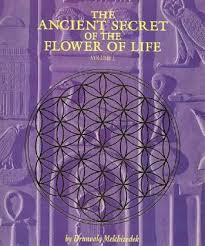
Drunvalo Melchizedek presents in text and graphics the first half of the Flower of Life Workshop, illuminating the mysteries of how we came to be, why the world is the way it is.
This book was suggested by Meme Mpuru for the Bookclub society next meeting.
The pineal gland, also known as the pineal body, conarium or epiphysis cerebri, is a small endocrine gland in the vertebrate brain. It produces melatonin, a serotonin derived hormone, which affects the modulation of sleep patterns in both seasonal and circadian rhythms.[1][2] Its shape resembles a tiny pine cone (hence its name), and it is located in the epithalamus, near the center of the brain, between the two hemispheres, tucked in a groove where the two halves of the thalamus join.
Nearly all vertebrate species possess a pineal gland. The most important exception is the hagfish, which is often thought of as the most primitive extant vertebrate.[3] Even in the hagfish, however, there may be a “pineal equivalent” structure in the dorsal diencephalon.
The pineal gland is the only midline brain structure that is unpaired (azygous). It takes its name from its pine-cone shape.[8] The gland is reddish-gray and about the size of a grain of rice (5–8 mm) in humans. The pineal gland, also called the pineal body, is part of the epithalamus, and lies between the laterally positioned thalamic bodies and behind the habenular commissure. It is located in the quadrigeminal cistern near to the corpora quadrigemina.[9] It is also located behind the third ventricle and is bathed in cerebrospinal fluid supplied through a small pineal recess of the third ventricle which projects into the stalk of the gland.[10]
Blood supply
the 3rd eye is in the miidle of your forehead,this is no myth we can view up and both sides but the eye does not look down.Its like having eyes at the back of yo head..lol
The pineal gland is originally the size of the circumference from your middle finger to your thumb.But these days diet and low frequency energy have killed it,its to most people the size of a pea.
We should meditate more,connect with the cosmos.Find ourselves through the spirit level and waken.Start to remember your dreams as they are inportant imprints of your true self (lucid dreaming).how do you know if your asleep and still dreaming or if you are in wake state?
LikeLiked by 1 person
Eish this book is deep…i love the obsure yet vastly complex ideas or the origin of man…as posed to Darwinism and Scientology.
Melchizedek goes through the spiritual to the phisycal merging of the universe with a human being.All the elemnts on the periodic table,all the constellation.The whole universe is inside of us,just close youe eyes and see,we are the universe and all in it.Everything is evrything.
for fibonacci,tree of life …the Sacred Geometry.
Im battling to finish this book in its complexity.
In mathematics, the Fibonacci numbers are the numbers in the following integer sequence, called the Fibonacci sequence:[1][2]
1 , 1 , 2 , 3 , 5 , 8 , 13 , 21 , 34 , 55 , 89 , 144 , … {\displaystyle 1,\;1,\;2,\;3,\;5,\;8,\;13,\;21,\;34,\;55,\;89,\;144,\;\ldots \;} 1,\;1,\;2,\;3,\;5,\;8,\;13,\;21,\;34,\;55,\;89,\;144,\;\ldots \;
Often, especially in modern usage, the sequence is extended by one more initial term:
0 , 1 , 1 , 2 , 3 , 5 , 8 , 13 , 21 , 34 , 55 , 89 , 144 , … {\displaystyle 0,\;1,\;1,\;2,\;3,\;5,\;8,\;13,\;21,\;34,\;55,\;89,\;144,\;\ldots \;} 0,\;1,\;1,\;2,\;3,\;5,\;8,\;13,\;21,\;34,\;55,\;89,\;144,\;\ldots \;.[3]
The Fibonacci spiral: an approximation of the golden spiral created by drawing circular arcs connecting the opposite corners of squares in the Fibonacci tiling;[4] this one uses squares of sizes 1, 1, 2, 3, 5, 8, 13, 21, and 34.
By definition, the first two numbers in the Fibonacci sequence are either 1 and 1, or 0 and 1, depending on the chosen starting point of the sequence, and each subsequent number is the sum of the previous two.
In mathematical terms, the sequence Fn of Fibonacci numbers is defined by the recurrence relation
F n = F n − 1 + F n − 2 , {\displaystyle F_{n}=F_{n-1}+F_{n-2},\!\,} F_{n}=F_{n-1}+F_{n-2},\!\,
with seed values[1][2]
F 1 = 1 , F 2 = 1 {\displaystyle F_{1}=1,\;F_{2}=1} F_{1}=1,\;F_{2}=1
or[5]
F 0 = 0 , F 1 = 1. {\displaystyle F_{0}=0,\;F_{1}=1.} F_{0}=0,\;F_{1}=1.
The Fibonacci sequence is named after Italian mathematician Leonardo of Pisa, known as Fibonacci. His 1202 book Liber Abaci introduced the sequence to Western European mathematics,[6] although the sequence had been described earlier as Virahanka numbers in Indian mathematics.[7][8][9] By modern convention, the sequence begins either with F0 = 0 or with F1 = 1. The sequence described in Liber Abaci began with F1 = 1.
Fibonacci numbers are closely related to Lucas numbers L n {\displaystyle L_{n}} L_{n} in that they form a complementary pair of Lucas sequences U n ( 1 , − 1 ) = F n {\displaystyle U_{n}(1,-1)=F_{n}} U_{n}(1,-1)=F_{n} and V n ( 1 , − 1 ) = L n {\displaystyle V_{n}(1,-1)=L_{n}} V_{n}(1,-1)=L_{n}. They are intimately connected with the golden ratio; for example, the closest rational approximations to the ratio are 2/1, 3/2, 5/3, 8/5, … .
Fibonacci numbers appear unexpectedly often in mathematics, so much so that there is an entire journal dedicated to their study, the Fibonacci Quarterly. Applications of Fibonacci numbers include computer algorithms such as the Fibonacci search technique and the Fibonacci heap data structure, and graphs called Fibonacci cubes used for interconnecting parallel and distributed systems. They also appear in biological settings,[10] such as branching in trees, phyllotaxis (the arrangement of leaves on a stem), the fruit sprouts of a pineapple,[11] the flowering of an artichoke, an uncurling fern and the arrangement of a pine cone’s bracts..
u do the math…..
LikeLike
Tree of life is amazing stuff…mind boggling
LikeLike
i think this should be the next book on discussion at the book club
LikeLike